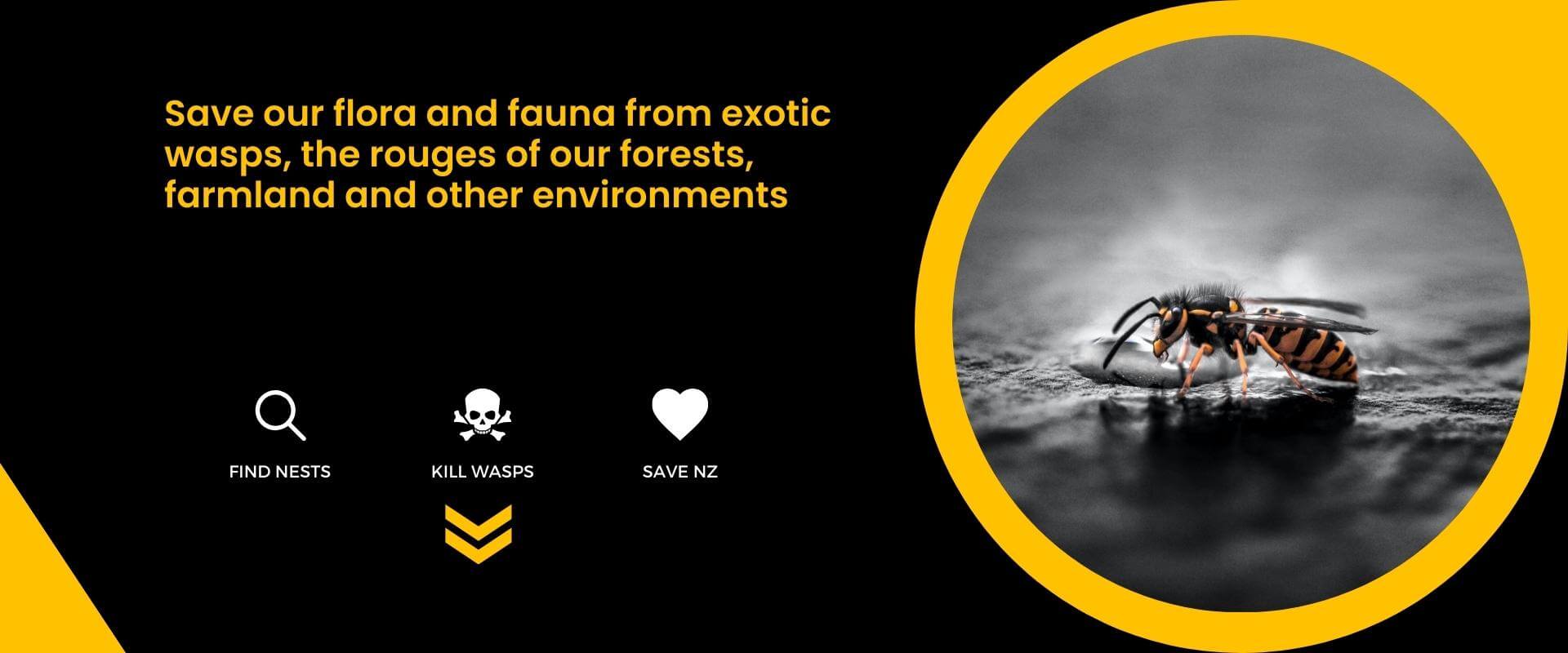
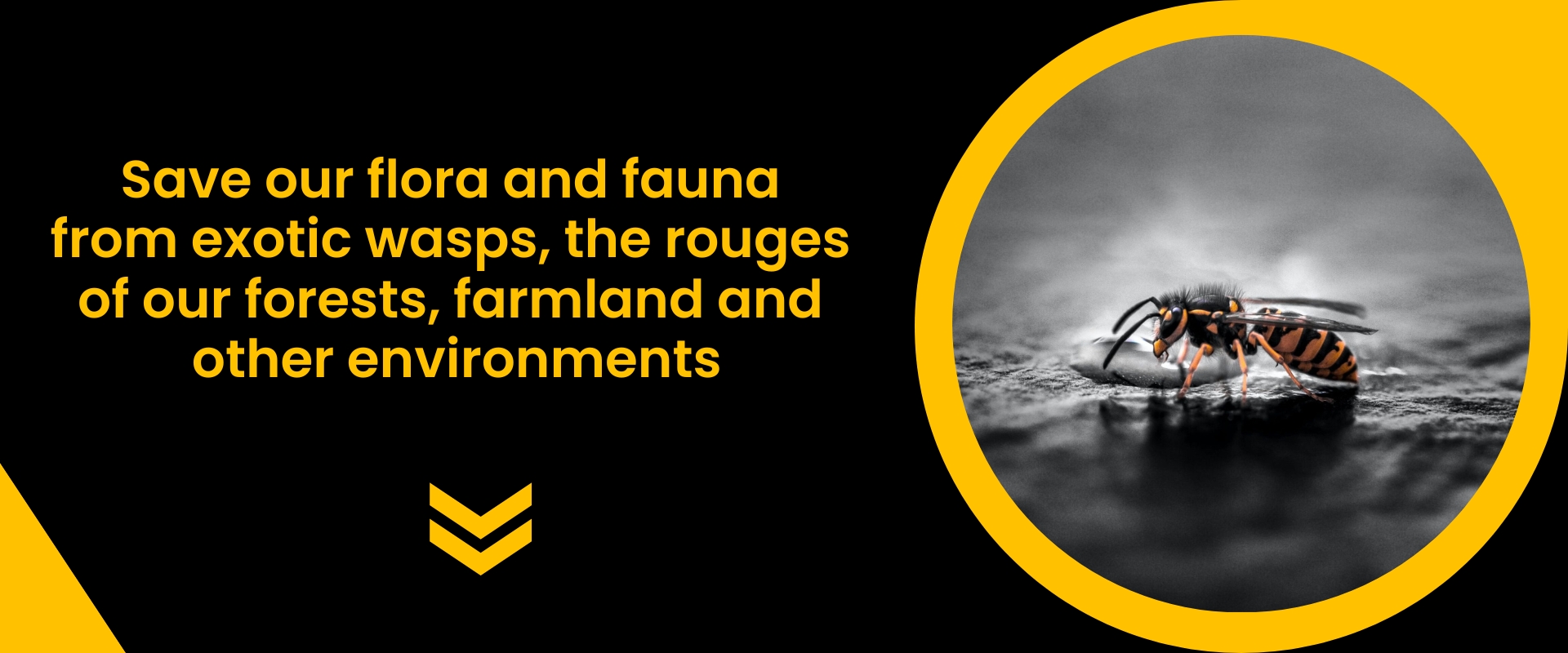
What wasps are rouges
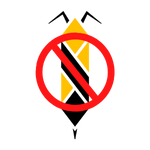
There are 2 species of Vespula (German and Common) wasps and 3 species of Polistes (Asian, Australian and European) paper wasps that are of great concern, all 5 species of wasps are social wasps.
Social wasps are those species that construct a nest (colony) in which a caste system develops; typically, with a queen laying eggs and ‘workers’ taking
care of the developing larvae, foraging for resources, and nest defence. Other insects with complex social systems include ants and some bees (which are both closely related to social wasps), and also termites.
Common and German wasps (Vespula vulgaris and Vespula germanica) do not have natural predators in New Zealand.
New Zealand has the highest densities of Common and German wasps in the world. In beech forest with honeydew, the biomass of social wasps (about 1100 g/ha/yr) is greater than that of all the native birds, upsetting the ecological balance in native ecosystems.
Also, they can spoil peoples’ enjoyment of the outdoors, as well posing a health risk affecting the profitability and safety of industries such as beekeeping, horticulture, forestry and tourism. Wasp nests and their occupants do not usually survive the winter, with all worker wasps along with the old queen, dying in April or May. However, the newly hatched queen wasps stay alive by hibernating in wood piles or behind the bark on trees.
The German wasp was first found near Hamilton in 1945; the common wasp has been in New Zealand since 1978.
As they do not have any natural predators, social wasps have become seriously invasive and a major problem everywhere in New Zealand. Honeydew is produced by a native scale insect and is an important food for native birds, bats, insects, and lizards.
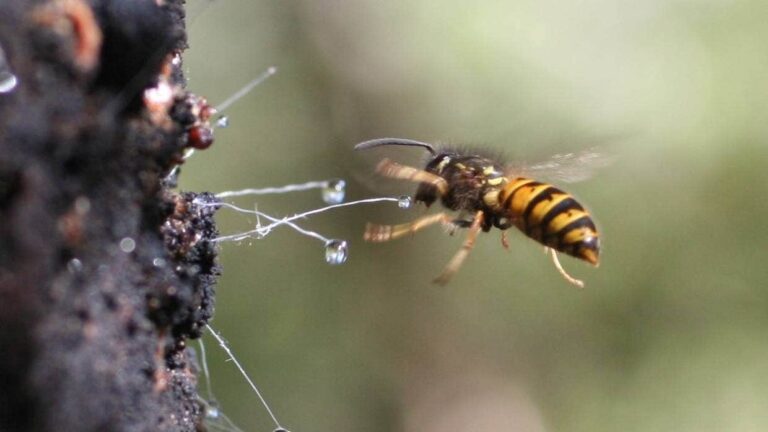
Vespula wasps compete for the nectar relied upon by NZ native birds, lizards, and insects.
Common wasps are very efficient at harvesting nectar, especially honeydew, and to a greater degree, have displaced German wasps from honeydew beech forests. Common worker wasps collect honeydew at a faster rate than German wasps and spend less time lapping honeydew (which has often fermented) from the trunk when the standing crop of honeydew is low, so, unlike German worker wasps, fewer become lethargic and less effective feeders.
German, Common and all paper wasps consume exotic and native insects, vulnerable animals such as baby birds, and other protein.
Though Common and German wasps consume massive quantities of honeydew, they also eat exotic and native insects at a certain point in their life cycle, usually late summer. However, paper wasps eat only live prey so throughout their life cycle they will kill all insects – they do not discriminate – devouring not only pest insects but honeybees, monarch caterpillars and butterflies, and dragonflies.
Vespula and Polistes wasps upset the natural food chain
By eating so much, exotic wasps upset the natural food chain of the forest (and in our urban environments) and are one of the main reasons why our forests are empty of life. Seasonally, in some beech forests there are an estimated 12 Common or German nests, or up to 10,000 worker wasps per hectare. This represents a greater biomass of wasps (3.8kg/ha) in a beech forest than all the native birds plus stoats and rodents put together. The highest number of nests recorded was 50–60 nests per hectare, the equivalent of 25–30 nests on a football field.
Biomass of pests in South Island beech forest
(grams per hectare)

A nest can produce between 1000 and 2000 queens per season, of which around 2% or on average 30 survive the winter. This may not seem good odds or high numbers, but you do the maths; 30 surviving queens each produce 30 surviving queens = 900 queens in 2 seasons multiplied by an average of 4500 wasps per nest or 4.05 million wasps – this is what our indigenous animals are up against.
Paper Wasps have No natural predators and are difficult to control
Had they natural competitors or predators, paper wasps would have become one of the most important natural controls of many kinds of garden insects or pests. However, unlike the German and common wasps, paper wasps will only eat live prey. This means their predation goes unchecked as there are no traps or lures that can be used to control the species. Commercially available ‘wasp traps’ are designed to attract Vespula wasps and contain baits such as fruit juices, fresh meat, or heptyl butyrate (found in many retailed wasp lures). None of these are attractive to the European, Asian, or Australian paper wasps. There has not been any type of trap identified as effective for this species.
That means they will not take Vespex or other protein bate bait, and therefore have a very serious impact on insects, especially our native insect species which have not evolved to combat such predators.
A serious problem for our Monarch Butterflies amongst other caterpillars
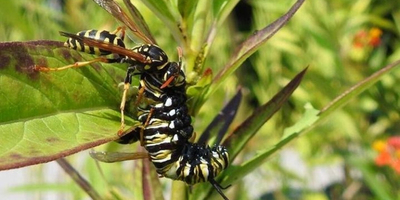
Paper wasps have had a particularly negative effect on caterpillar populations, especially Monarch butterflies. It was reported by Stuff that In 2016 Nelson, and in 2019 Taranaki, were particularly hard-hit by explosions of paper wasps, identified as Polistes dominula or the European Paper Wasp, resulting in the decimation of the local Monarch butterfly populations. But this is really happening all over New Zealand.
What do rouge wasps look like?

There are 5 wasp species of considerable concern; the Common Wasp, the German Wasp, the European Paper Wasp, the Tasmanian or Australian Paper Wasp and the Asian Paper Wasp, all accidentally introduced to New Zealand.
The Common and The German Wasp
German and common wasps are very similar in appearance. The dorsal markings on the abdomen have often been used to distinguish these two species in New Zealand. However, these markings are variable and are not always accurate. The marking on the side of the head and face are more reliable.


The Tasmanian Paper Wasp (Polistes humilis)
The Tasmanian paper wasp is red and brown and can be more easily distinguished from other paper wasp species (which are black and yellow), by its overall reddish-brown colour coupled with orange / brown stripes and thin yellow striations . The worker size ranges from 10–15mm. The queen is much larger – up to 2.5mm. They are a social species that build nests out of chewed up plants or wood material mixed with saliva. The nests are located under eaves or the underside of branches and leaves. Nests have an open structure (you can see the wasps resting and the nest structure), are normally quite small (maximum 100-200 wasps) and hang by a stalk. They tend not be aggressive but can be territorial if their nest is threatened and will sting if they feel the need. They will sting and eat caterpillars, and consume nectar, honey dew and fruit. Generally confined to the North Island.
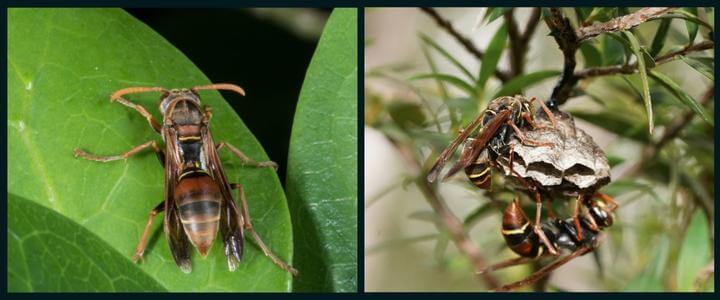
The Asian Paper Wasp (Polistes chinensis)
Asian paper wasp, a recent arrival in New Zealand (late 1970s), are very similar to the Australia paper wasp in temperament, behaviour, nest size and structure. It has a black and yellow colouration, which can cause it to be confused with the European and German wasps. The Asian paper wasps are distinguished by their body shape, which is slenderer and 13-25mm long. They have reddish-brown to black bodies with yellow rings and reddish areas on the abdomen. The wings are reddish or amber brown, and they have long legs that hang down during flight. The Asian paper wasp is larger than the Australian paper wasp.
Polistes chinensis hails from Japan and parts of China, and occurs on Hokkaido, the northern island of Japan, which can get as cold as the southern South Island. Hence why it has already spread throughout the entire country.
Unlike the German and common wasps, paper wasps only eat live prey. That means they won’t take Vespex bait, and they’re that much worse for our native insects.

The European Paper Wasp (Polistes dominula)
The European paper wasp is a generally black insect marked with yellow. They are fairly slender-bodied insects around 19mm long with a distinct constriction of the body between the thorax and abdomen also known as a “thread waist”. A “thread waist” is a common phrase used to identify the definite narrowing of the body between the thorax and abdomen.
The European paper wasp is superficially similar to and commonly mistaken for the Asian paper wasp and Vespula species (common and German wasps). European paper wasps rear their young on live insects. European paper wasps will sometimes feed on sweet materials, including honeydew produced by aphids. On rare occasions, they also may feed and damage ripe fruit. This habit is particularly notable in cherries and some other well-ripened stone fruits grown in such places as Nelson, the Hawkes Bay, and Central Otago where they may become serious pests.
Most commonly, they feed on insects but especially caterpillars, including the larvae of Monarch butterfly caterpillars, white butterfly caterpillars and cabbageworms, and others.
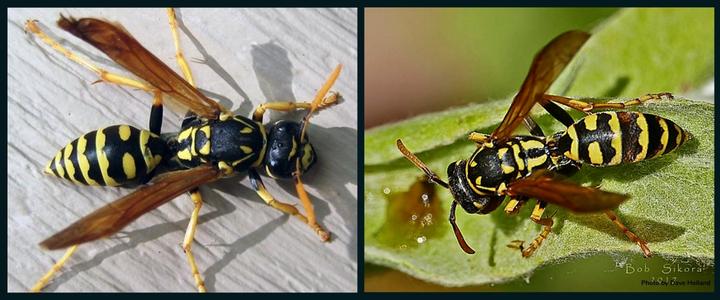
COMPARISON OF ALL FIVE WASP SPECIES
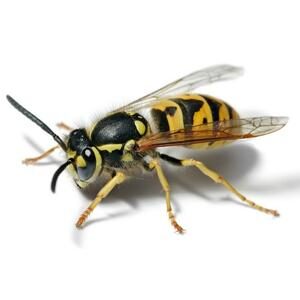
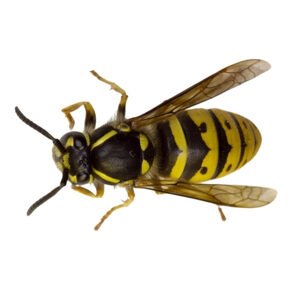
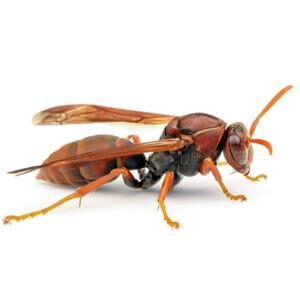
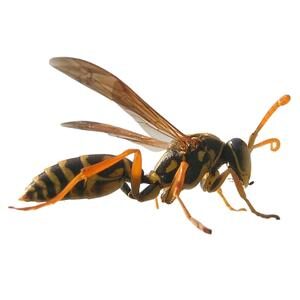
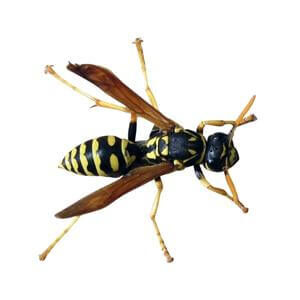
identifying wasp nests

The Common and German wasp nest
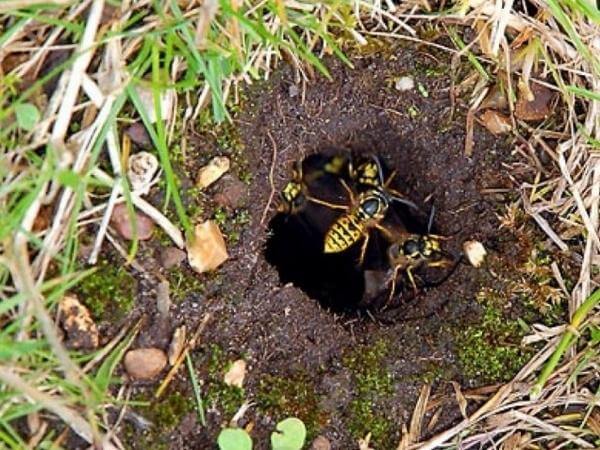
inground nest
The Common and German wasps in New Zealand are most likely to build their nests in a hollow in the ground. This is usually in a dry place that is protected from excessive heat and rain such as in a bank or under a tree stump. However, in Central Otago you will find nests almost anywhere, in the middle of a paddock, beside a walking track or concealed in bracken. The hole to the nest will be a single entrance and may be hidden in vegetation, but you may be able to identify it as the wasps will create a tunnel through the vegetation to the landing point on the ground at the entrance to the nest.
nest in house
When common or German wasp nest in a house or structure it is usually inside the eaves, or some other place hidden from view. However, there will be a small hole, perhaps at the join between soffit and wall where the wasps land and walk inside.
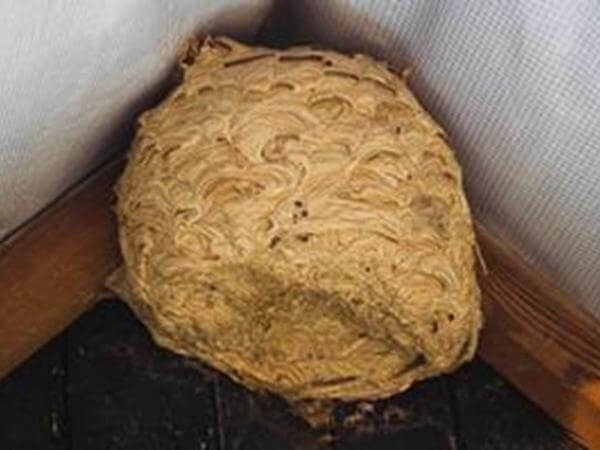
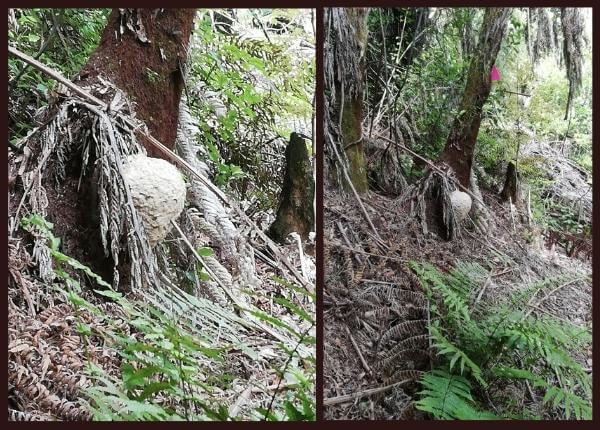
paper wasps
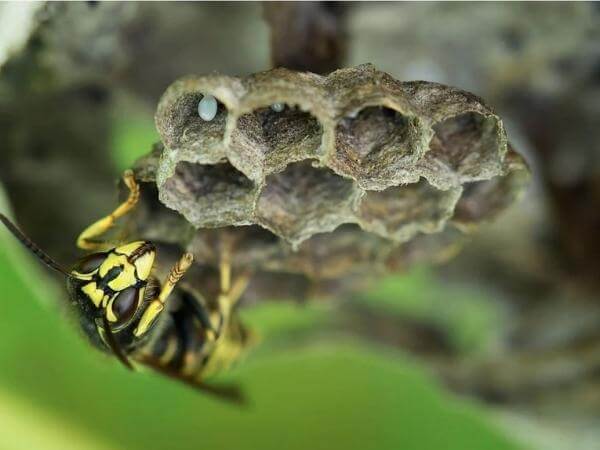
Paper Wasps Nests
Paper Wasps build nests in small shrubs and trees (the underside of branches and leaves), on fences and walls and often under the eaves of houses. Nests have an open structure (you can see the wasps resting and the nest structure), are normally quite small (maximum 100-200 wasps), usually less than 20 cm in diameter, and hang by a stalk. The cells are in a single layer, do not have an outer covering (i.e., you can see into the cells unlike Vespulid
nests where the layers of cells are enclosed in an envelope) and the roof is covered in a shiny secretion that acts as water-proofing.
The wasp prepares this paper ‘plaster’ by scraping tiny shavings of wood from old fence posts and rotten branches and mixing it with saliva. The queen wasp shapes the plaster into a series of chambers or cells, into each of which she lays a single egg.
The Asian Paper Wasp or Polistes chinensis
asian paper wasp
Asian paper wasp or Polistes chinensis can now be found as far south as Otago. In the north, Asian paper wasps are now very abundant in gardens, around farms, and in scrub and shrubland.
These guys are smaller and thinner than the German and Common Wasps; they are yellow and black and have long legs which dangle below their bodies when in flight. The Asian Paper Wasp was accidently introduced in the late 1970s and was wide spread by 1995.
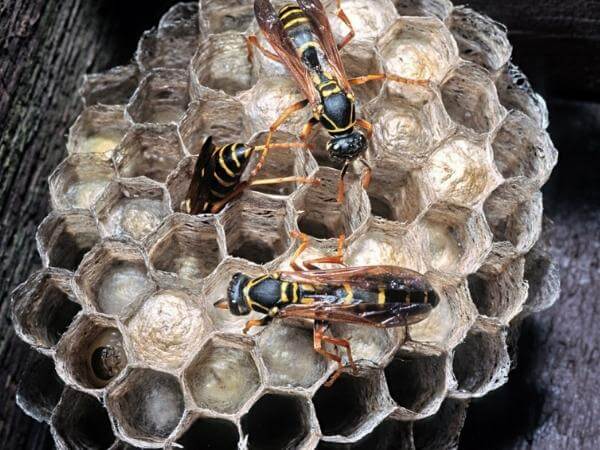
The tasmania (australian) paper wasp or Polistes humilis

Tasmanian paper wasp
The Tasmanian Paper Wasp can be more easily distinguished from other paper wasp species which are black and yellow, by its overall reddish-brown colour coupled with orange/brown stripes and thin yellow striations. Their size ranges from 10-15 mm. They can be very territorial if their nest is threatened. They can sting and eat caterpillars, consume nectar, honeydew and fruit. Generally confined to the North Island.
The European Paper Wasp Polistes dominula
european paper wasp
The dominant females are the principal egg layers, while the subordinate females (“auxiliaries”) or workers primarily forage and do not lay eggs.
Nests are almost always established in new locations each year and several kinds of nest sites are particularly favoured (New nests sometimes are established at the same site the following year). Dark cavities are often used, including those found in outdoor grills, large bells, pipes, rock cavities, and hollow spaces behind walls. Nests are also commonly attached to wood on the underside of porch decks, eaves of homes or other overhangs. Nests are almost always attached to either wood, roughened metal surfaces, or rock.
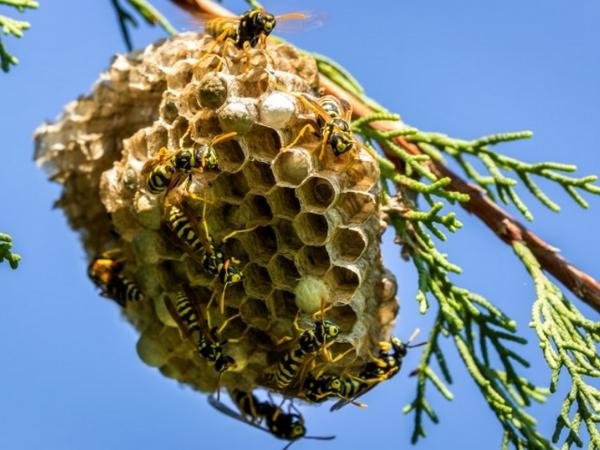
new zealand native wasps

native wasp legends
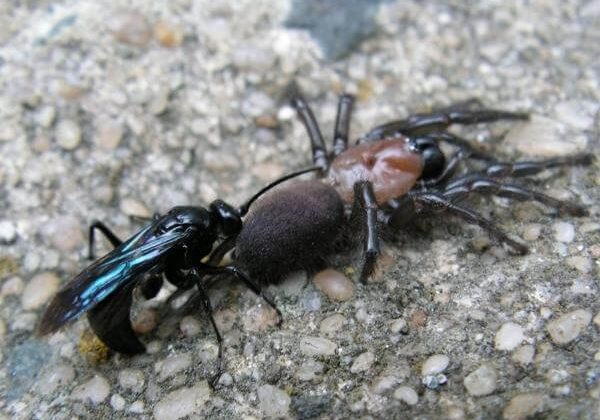
new zealand native wasps
New Zealand has 29 native stinging wasp species (and hundreds more that are tiny and inconspicuous) which rarely sting and are solitary hunters – more intent on finding food for their offspring. They tend to live in burrows in the ground. The biggest and most conspicuous are in the family Pompilidae, with 11 species, all prey on spiders, which they paralyse with venom and then drag into their ‘nest’ – usually a hole in the ground. The other family, the Sphecidae, the closest relatives to bees, are mostly smaller and darker, of which there are 18 species. They prey on various insects and spiders.
the common mason wasp
The commonly seen mason wasp (Pison spinolae) makes nest cells out of mud, and stocks them with paralysed orb-web spiders. These insects are all solitary, so don’t form big swarms around a colonial nest.
Unlike bees, the mason wasp is able to use its stinger repeatedly. It relies on this to inject venom into spiders which paralyses them and allows the adult female to carry the spider back to the nest. Unlike some commonly-known wasps, P. spinolae is not black and yellow, the adult’s body is fully black and has a length of approximately 16 millimetres (0.63 in).
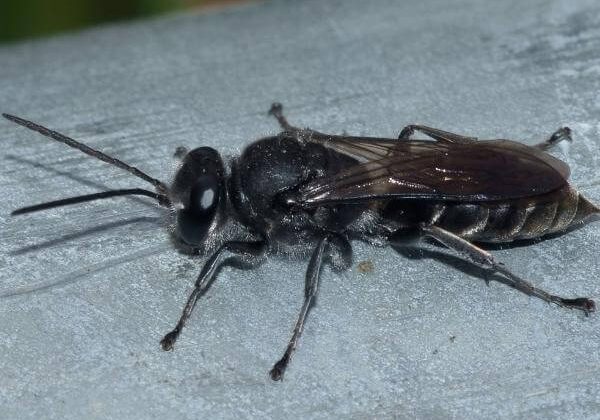
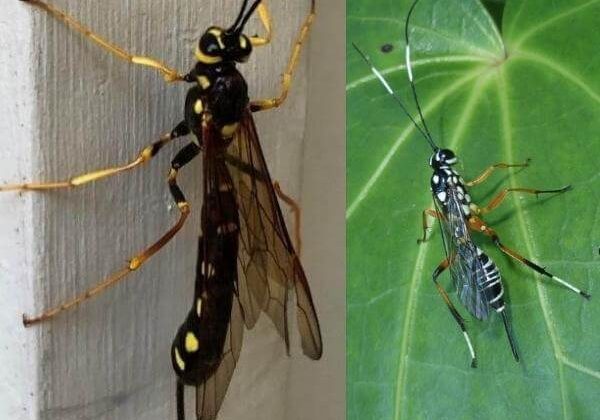
the giant ichneumon wasp
These wasps can be very large, the giant Ichneumon wasp can be up to 10 cm long but are not a danger to humans and are not a pest. One of the good guys, Xanthocryptus novozealandicus lays its eggs in weevil larvae.
biological war on wasps

Scientists are developing a range of tools for controlling wasps. It is likely that several methods will be needed to solve our wasp problem.
fight against the Sirex Wood Wasp
Some exotic wasps have been introduced to New Zealand to rid us of insects and wasps that have become pests or rogues.
A sirex woodwasp (Sirex noctilio) lays eggs in the trunk of a pine tree. At the same time, she also introduces a fungus that digests wood, making it easier for her larvae to bore through the wood. The sirex wasp was accidentally brought to New Zealand and was a pest in pineplantations until parasitic wasps that target it were used to control it.
The parasitic ichneumon wasp (Rhyssa persuasoria) lays its eggs on the larvae of the sirex wasp, deep inside a pine tree. It was introduced as a means of controlling the sirex epidemic.
THE BAD GUY OR ROUGUE OF THE FOREST
Sirex woodwasp
The wood wasp, Sirex noctilio lays eggs in living trees (Pinus radiata) and at the same time deposits mucus and fungus into the wood. The mucus causes the foliage to wilt and makes conditions in the tree suitable for the spread of the fungus. Susceptible trees may die. The larvae tunnel through the fungus-infected wood, and the adults make round exit holes when emerging. Resin may ooze from egg-laying (oviposition) holes drilled by sirex. Even if the attack is unsuccessful, a degradation of the timber may occur because of resin accumulation or killed zones in the wood.
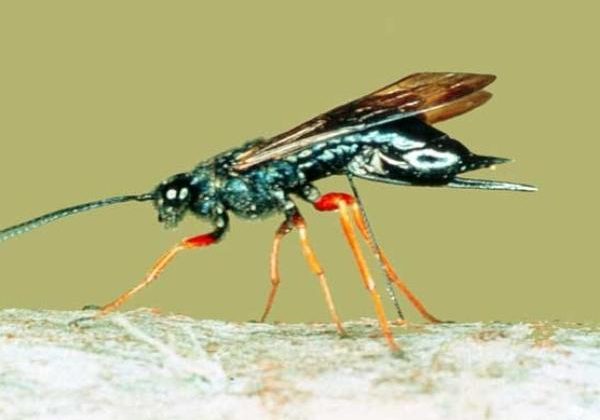
THE GOOD GUY OR LEGEND OF THE FOREST
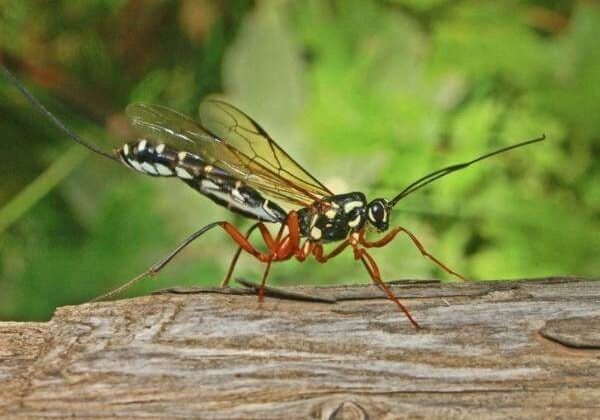
Giant ichneumon wasp
They look scary because of their large and very long ovipositor but they are the good guys and can’t sting, so don’t squash them!
The female of this parasitic family drills deep into wood by its hair thin ovipositor (terebra) and lays its eggs on larvae living deep in timber (up to 40 mm), which become a food supply and an incubator for the progeny until it is fully grown. Most species of Ichneumonidae wasps have one generation per year (univoltine). Larvae overwinter in the wood, pupating the next spring and emerging from the wood as adults.
fight against Common and German Wasps
Approval has been granted to import and release two new organisms, a hoverfly and beetle, in a bid to reduce plague populations of invasive German and common wasps in New Zealand.
New biocontrol tools for wasps and pests
The Tasman District Council applied to introduce the wasp-nest beetle, Metoecus paradoxus, and a hoverfly, Volucella inanis, for biological control of the wasps Vespula germanica and V. vulgaris.
In its application to the Environmental Protection Authority (EPA), Tasman District Council said using the hoverfly and beetle as biological control agents would be a sustainable option to target hard-to-reach wasp populations and would reduce the damage they cause.
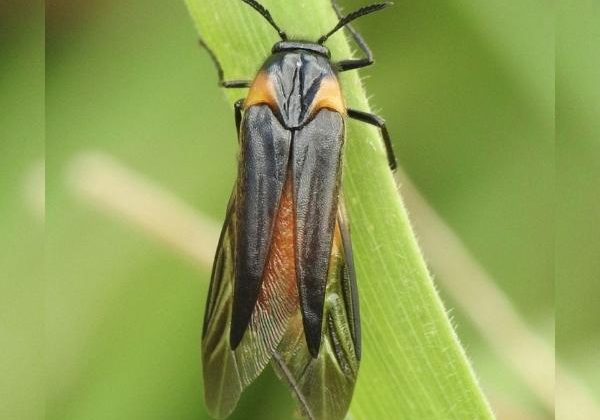
Wasp-nest Beetle
This is a rather odd-looking, almost fly-like, insect about 10 mms long with narrow pointed elytra which do not completely cover the wings or abdomen. It has feathery antennae and is a parasite of wasps’ nests.
The adult lays eggs on rotting wood in the hope that a wasp will visit to harvest wood fibre for its nest. If one does, the beetle larva climbs onto the back of the wasp and is transported to the nest. It then seeks out a wasp grub and parasitises it. The beetle grows and pupates and emerges as an adult just after the time the wasp would have done.
Hoverfly
The adults reach 15–17 mm (0.59–0.67 in) long. They have three yellow bands on an otherwise black abdomen and thus closely resemble wasps in a form of mimicry. The first two bands are completely or partially interrupted by a black wedge. The head has feather-like antennae and the wings have darkened patches in the middle and on the tip.
The female lays eggs in the nests of social wasps and hornets. The larvae of this hoverfly live on the outside of wasp grubs, eventually killing them.
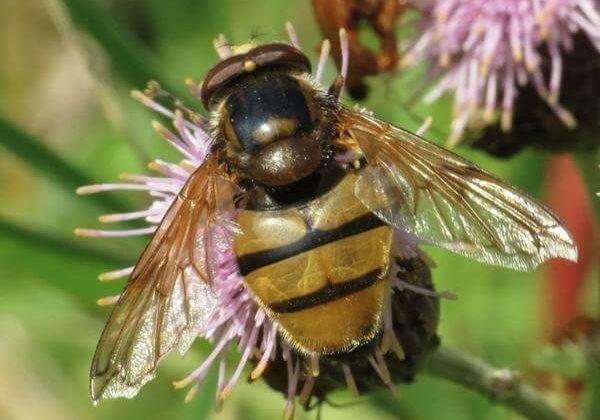
Health & Safety around wasps and wasp nests
Be prepared for a potential sting and take all precautions against upsetting the wasps in a nest.
It is important that you understand that wasps can sting and unlike bees, which can only sting once,
are able to sting several times and through clothing as well!
Children – never try to waste a wasp nest without an adult present
